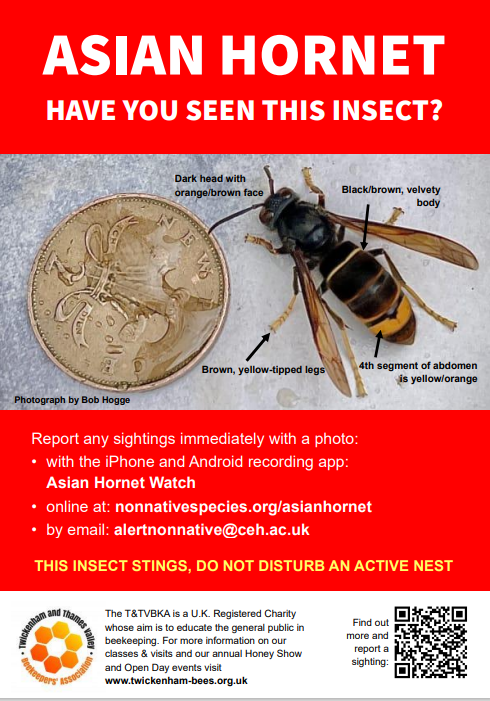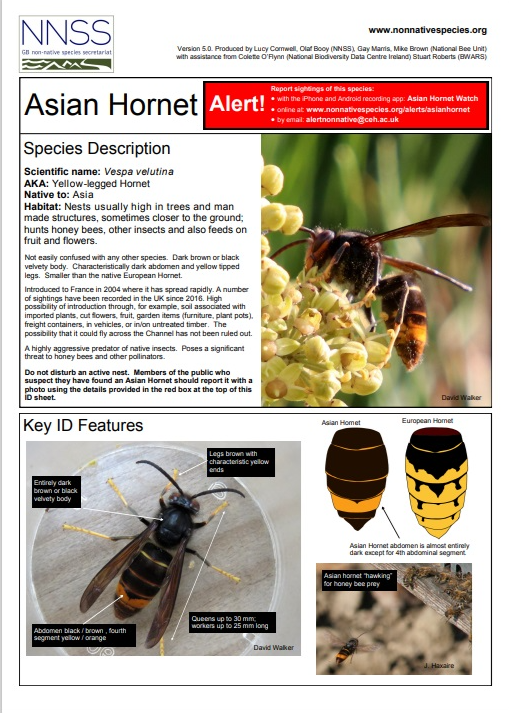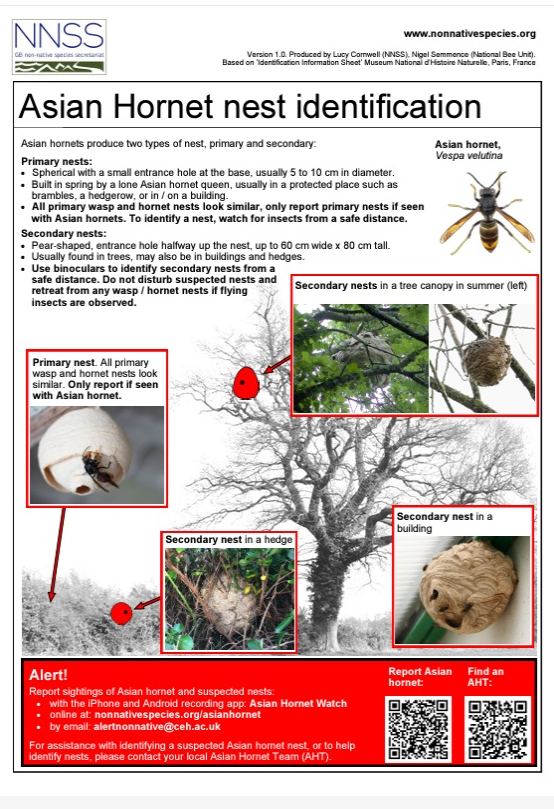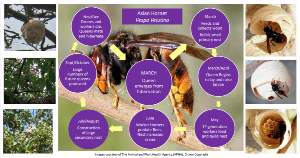The Yellow-Legged Asian hornet, vespa velutina, is an aggressive non-native predator of insects that poses a significant threat to not only honey bees but other pollinators such as bumblebees, butterflies & hoverflies.
Just one hornet can hunt down and eat 30 – 60 bees a day. Hawking activity outside the hive causes a colony to mount a constant defence and limits foraging time, leaving it weakened and vulnerable to disease, robbing, infestation and ultimately colony loss.
| The situation today | Why are they a threat? | How you can help |
| What to look for | Where and when to look | How to report a sighting |
| What are Beekeepers doing? | Useful information |
The situation today
Accidentally introduced to south-west France in 2004, the insect has rapidly spread across northern Europe and was first discovered in the UK in 2016.
By 2022, just 16 Asian Hornet nests had been discovered in this country. But in 2023, this increased dramatically to 72 nests in 56 different locations with two confirmed sightings of the insect in London for the first time. Kent and other counties along the south coast took the brunt of the incursion, but there have been sightings in locations across the country, including as far north as Scotland.
So far this year, 2025, there have been 342 credible Yellow-legged hornet sightings in the UK and 86 nests have been found.

Why are they a threat?
Yellow-legged Asian hornets are a significant threat to the UK’s biodiversity and wildlife. An individual hornet hovers outside of the hive, known as hawking, picking off between 30-60 individual bees a day. But his behaviour also stops the bees from foraging to collect nectar and pollen to feed themselves, leaving the colony weak and vulnerable to several threats and ultimately lead to the loss of the colony.

In addition to honey bees, Asian hornets predate on other important insect pollinators. With just one nest of hornets consuming up to around 11kg of insects in a year their arrival could have huge consequences to the wider ecology and economy. In France, where the Asian hornets have become established, the cost to the economy is estimated to be in excess of £26 million every year.
Furthermore, this is now an issue of public health concern. While one hornet is unlikely to cause a problem, these insects are aggressively defensive of their nests, which are often built in bushes, hedgerows, brambles, and trees, meaning disturbances by unsuspecting individuals could have dangerous consequences.
Outdoor workers such as tree surgeons, landscapers, gardeners & allotment holders; anglers & sportspeople; ramblers & dog walkers, in fact, anyone who works in, or enjoys the outdoors needs to be aware of the potential presence of Asian Hornets and the action to take if they come across one.
How you can help
There are 3 Easy Steps you can take to help:
1. See it – Learn how to identify Asian Hornets,
2. Snap it – Take a photograph,
3. App it – Report your sighting on the ‘Asian Hornet Watch’ app.
And spread the word. Tell your neighbours, your friends, your colleagues…Communication is key: the more people who know about this insect, the more chance we have of limiting its impact.

What to look for
Yellow-legged Asian hornets can be identified by their very distinct markings: they’re slightly smaller than our native European hornet, which is two or three times the size of a common wasp, and are black with an orange face, a thin yellow band near the middle and a broader orange/yellow band around their abdomen, near the tail. The most distinguishing characteristic is their bright yellow legs, like they have been dipped in a pot of yellow paint – hence the name.
The distinct ID features to look out for are:

- Dark head with orange/brown face
- Yellow-tipped Legs
- 4th Segment of abdomen is yellow/orange
- Black, velvety thorax (body)
- Dark wings
- Thin yellow band on abdomen
- Queen up to 30mm long, worker up to 25mm long
Download the NNSS Yellow-legged Asian hornet Identification sheet
Where and when to look
Spring
Asian Hornets are active from February to November. February to March marks the beginning of the Asian hornet year when mated queens emerge from hibernation and start to build nests. The lone queen will build a small, primary nest in a sheltered area such as hedgerows & bushes and in outbuildings such as sheds. As the colony and nest size increases, a larger nest is either established around the primary nest or they relocate and build a secondary nest close by.
Primary nest – Spherical with small entrance hole at the bottom, usually 5 –10cm in diameter. Usually in a protected place such as brambles and hedgerows and in/on outbuildings.
Summer

In the summer months, a single colony produces, on average, 6,000 hornets. From July onwards, honey bee predation begins and increases until the end of November. Hornets can be seen ‘hawking’ or hovering outside a hive entrance, waiting for returning foragers. When Asian hornets catch a returning honey bee, they pull apart the bee, taking only the protein rich thorax back to the nest where it is fed to the hornet larvae.
Secondary nest – Pear-shaped, entrance hole halfway up the nest, up to 60 cm wide x 80 cm tall. Usually found in trees, may also be in buildings and hedges. Do not disturb suspected nests.
Download the NNSS Yellow-legged Asian hornet Nest Identification sheet.
Autumn
During autumn, the colony’s priorities change from foraging and nest expansion to producing gynes (queens) and males (drones) for mating. Shortly after mating the fertilised queens will leave the nest and find somewhere suitable to over-winter, while the old queen will die, leaving the nest to dwindle and die off. The following spring, the founding queen will start building her new colony and the process begins again. Each Asian hornet colony produces on average 350 gynes (queens), however only a small number will successfully mate and make it through winter to establish a nest the following year.
How to report a sighting
Reporting a possible Yellow-legged Asian hornet sighting is quick, free, and easy and has the potential to make a huge difference in the fight against this invasive species. You can report sightings with the Asian Hornet Watch app available for iPhone and Android, online at nonnativespecies.org/asianhornet or by email at alertnonnative@ceh.ac.uk.
What are Beekeepers doing?
Recognising the urgency of the situation, the British Beekeepers Association (BBKA) and local beekeepers including members of the TTVBKA are actively involved in monitoring and addressing the Asian hornet invasion. We work in collaboration with government agencies, researchers, and local communities to develop strategies for early detection and eradication of these invasive pests. BBKA & TTVBKA staff and volunteers are trained to identify Asian hornets and their nests and report their findings to the Government’s National Bee Unit (NBU). The NBU sends bee inspectors to destroy confirmed nests, with DNA tests conducted to help to trace and monitor the progress throughout the UK.
In addition, the TTVBKA is actively involved in raising awareness about the Asian hornet invasion. We can provide organisations and members of the public with identification sheets and alert posters, advise on traps and bait stations, have speakers available to educate and inform organisations and the media on the Asian Hornet and the threat to UK pollinators and provide articles for inclusion in newsletters and articles. Please email ah-ttvbka-comms@twickerbees.co.uk if you would like to help us spread the word.
Useful Information
| Download Yellow-legged Asian Hornet Alert Poster | Download Yellow-legged Asian Hornet Identification Sheet | Download Yellow-legged Asian Hornet Nest Identification Sheet |
 |  |  |
| Download Yellow-legged Asian Hornet Life Cycle Graphic | Watch BBKA Yellow-legged Asian Hornet Awareness Film |
 |  |
Remember,
See it!! Snap it !! App it!!


